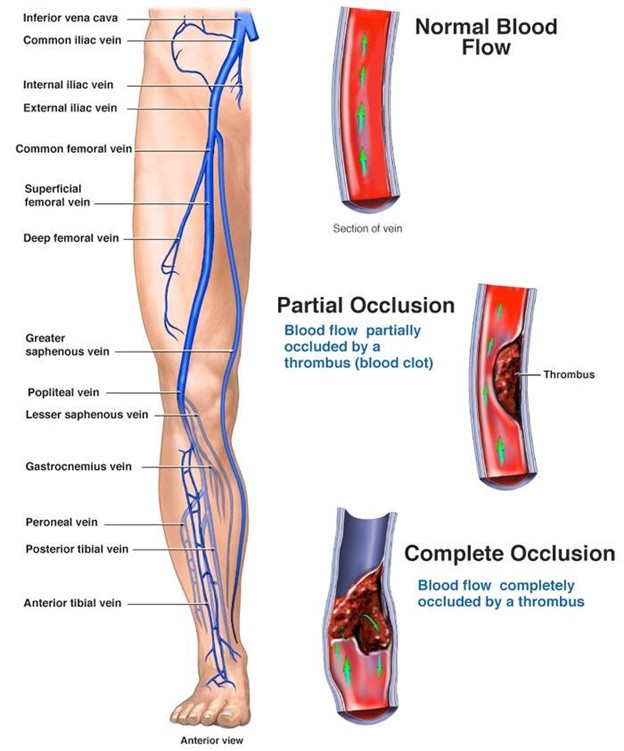A nurse is caring for a client who is 12 hr postpartum and has deep-vein thrombosis of the left leg. The client is receiving anticoagulant therapy. Which of the following actions should the nurse take?
Massage the affected extremity every 4 hr.
Initiate bed rest.
Apply an ice pack to the effected extremity for 20 min every 2 hr.
Administer aspirin for pain.
The Correct Answer is B
Deep-vein thrombosis (DVT) is a condition where a blood clot forms in a deep vein, usually in the legs. Bed rest is often recommended for clients with DVT to reduce the risk of the clot dislodging and causing a pulmonary embolism. By minimizing movement and keeping the leg elevated, the nurse can help prevent further complications.
The other options listed are incorrect:
- Massage the affected extremity every 4 hours: Massaging the affected extremity can dislodge the clot, increasing the risk of a pulmonary embolism. It is contraindicated and should not be performed in clients with DVT.
- Apply an ice pack to the affected extremity for 20 minutes every 2 hours: While applying cold compresses or ice packs may be useful in some situations to reduce swelling or pain, it is not recommended for clients with DVT. Heat application or cold application should be avoided because they can promote blood circulation and potentially dislodge the clot.
- Administer aspirin for pain: Aspirin is not typically used for pain management in DVT. Anticoagulant therapy is the primary treatment for DVT, and specific anticoagulant medications are prescribed to prevent further clot formation and reduce the risk of complications.

Nursing Test Bank
Naxlex Comprehensive Predictor Exams
Related Questions
Correct Answer is C
Explanation
Regular physical exercise has been shown to promote better sleep. Engaging in daily exercise can help regulate the sleep-wake cycle, promote relaxation, reduce anxiety and stress, and increase overall sleep quality. It is important to note that exercise should ideally be done earlier in the day, at least a few hours before bedtime, as exercising too close to bedtime may actually have a stimulating effect and make it harder to fall asleep.
The other options listed are not the most appropriate recommendations for addressing difficulty in falling asleep:
- "Sleep longer hours on the weekend." This suggestion may disrupt the client's sleep routine and can lead to inconsistent sleep patterns throughout the week, potentially making it more challenging to fall asleep on subsequent nights.
- "Keep the television volume low while you are trying to fall asleep." It is generally recommended to create a sleep-friendly environment, which includes reducing external stimuli like noise, light, and electronic devices in the bedroom. However, watching television right before bedtime can interfere with sleep as the bright light and stimulating content can keep the mind awake.
- "Remain in bed until you fall asleep." This recommendation may contribute to increased frustration and anxiety if the client is unable to fall asleep quickly. It is generally advised to practice good sleep hygiene, which includes getting out of bed if unable to fall asleep after a reasonable amount of time and engaging in a relaxing activity until feeling sleepy again.
Correct Answer is A
Explanation
Explanation:
A nasal cannula is a device used to deliver supplemental oxygen to a client. It consists of two prongs that are inserted into the client's nostrils and connected to an oxygen source. The nasal cannula is commonly used for low-flow oxygen delivery at a rate of 1 to 2 liters per minute (L/min).
The other options mentioned are not necessary supplies for the client upon discharge:
B- Petroleum jelly is not directly related to oxygen therapy and is not a required supply for the client. It is a common topical ointment used for various purposes such as moisturizing the skin or protecting the lips, but it is not specifically needed for oxygen administration.
C- An oxygen mask is an alternative device for oxygen delivery but is not typically used at a flow rate of 1 to 2 L/min. Oxygen masks are usually employed for higher flow rates or in specific clinical situations that require a different oxygen delivery method.
D- A reservoir bag is a component of some oxygen delivery systems, such as a non-rebreather mask or a bag-valve-mask device. However, at a flow rate of 1 to 2 L/min, a reservoir bag is not typically used. It is more commonly utilized in situations where higher oxygen concentrations or higher flow rates are required.
Whether you are a student looking to ace your exams or a practicing nurse seeking to enhance your expertise , our nursing education contents will empower you with the confidence and competence to make a difference in the lives of patients and become a respected leader in the healthcare field.
Visit Naxlex, invest in your future and unlock endless possibilities with our unparalleled nursing education contents today
Report Wrong Answer on the Current Question
Do you disagree with the answer? If yes, what is your expected answer? Explain.
Kindly be descriptive with the issue you are facing.
